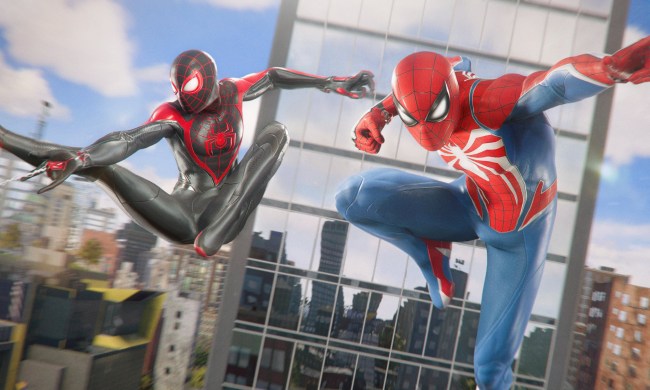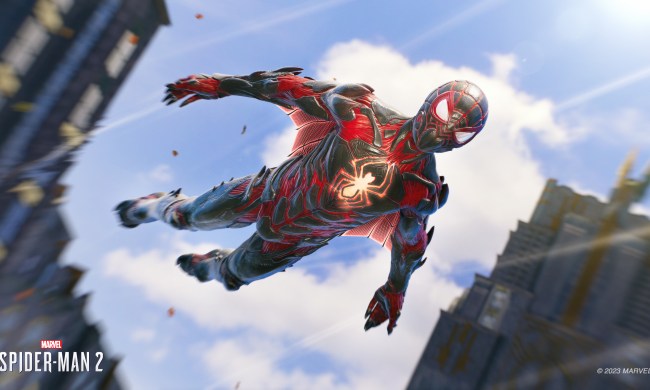
The new Spider-Man game from developer Beenoz and publisher Activision puts you in the role of four different Spider-Men from different times and dimensions, all with their own looks and moves. If you are not a comic fan, you probably aren’t familiar with the concept of multiple universes (weirdo). In the Marvel Universe, there are multiple dimensions, each with their own history. Usually the characters are the same people just in different situations, but not always. The names might be the same, but in some cases that is as far as the similarities go.
In the game Spider-Man: Shattered Dimensions, you play as four different versions of Spider-Man. The game begins when a mystical artifact called the Tablet of Order and Chaos is broken into four pieces and spread over four dimensions, causing problems with all of reality. When a sorcerer tells Spider-Man of the situation, Spider-Man then is forced to get help from other versions of himself to find and reunite the pieces of the tablet.
You play as four unique versions of Spider-Man, each with their own style of play, move-set, and graphical look. The plot carries through all four dimensions, but the main plot becomes a backdrop to the setting and ongoing stories of each of the main characters, as they go about their own lives and adventures.

The first Spider-Man you play as is the Amazing Spider-Man from the Marvel Universe that we all know, called Earth-616. This Spider-Man wears the iconic red and blue outfit, and plays in a style you might consider more traditional for Spider-Man with a heavy emphasis on acrobatics, melee attacks, and several webbing based movements. Each of the Spider-Men’s dimensions will have a graphical look that is specific to them, and the Amazing Spider-Man’s look is based on the comic book, with bright colors and a cell-shaded style that is fitting for a comic book.
The second Spider-Man is Spider-Man Noir, from Earth-7207- a Spider-Man set in depression-era 1930s New York. This Spider-Man’s style is more based on stealth. He uses sneak attacks and fights like a brawler when caught, before retreating to the shadows. The look is darker and grainier in fitting with the noir tradition, and the colors play a huge part in the levels. When Spider-Man is in the shadows, the world is slightly more monochrome, but when he is seen, the colors take on an extremely bright look to signify that you are exposed. This Spider-Man is based on the ongoing Marvel Noir series.
The third Spider-Man is a fan favorite, Spider-Man 2099 from Earth-928. This Spider-Man is not actually Peter Parker, but rather Miguel O’Hara, a geneticist that gained spider abilities from a gene splicing mishap. The character comes from the short lived Marvel 2099 series that gained a huge cult following but was ultimately ended due to budgetary concerns and shakeups at Marvel. This version of Spider-Man is much more sci-fi based than the others, and the setting and look match that feel. Set in the police-state city of Nuevo York, Spider-Man 2099 has several similar, but different abilities from the other Spider-Men. While he lacks “spider-sense”, his vision is especially acute and allows the gamer to see targets and obstacles coming up, his outfit also allows his a slight gliding ability, and he has talons on each finger. The look is more high tech, and the levels seem to move faster.
The fourth dimension has not yet been announced, but speculation has ranged from a symbiotic Spider-Man similar to Venom, to Spider-Man: India, to Zombie Spider-Man. We’ll have to wait until ComicCon to find out for sure.

From what was debuted at E3, the detail in the game is incredible, and the graphics have been heavily emphasized- especially the lighting effects that looked unreal in Nuevo York, and became part of the gameplay for Spider-Man Noir. While each character might have their own moves and styles, the core mechanics seems to move in a similar fashion for each- which is a good thing. The character animations also look spot-on, which is a must for any Spider-Man game that will rely on acrobatic and unusual movements.
Beenox are planning on at least 12 hours of gameplay, with three levels available for each version of Spider-Man and each level taking at least an hour. There are also several unlockables, as well as exclusives skins, like Cosmic Spider-Man that is available as a pre-order reward from Game Spot, and Iron Spider-Man, available when you order through Amazon.
Expect to hear more about this game as its September 7 release date nears.


